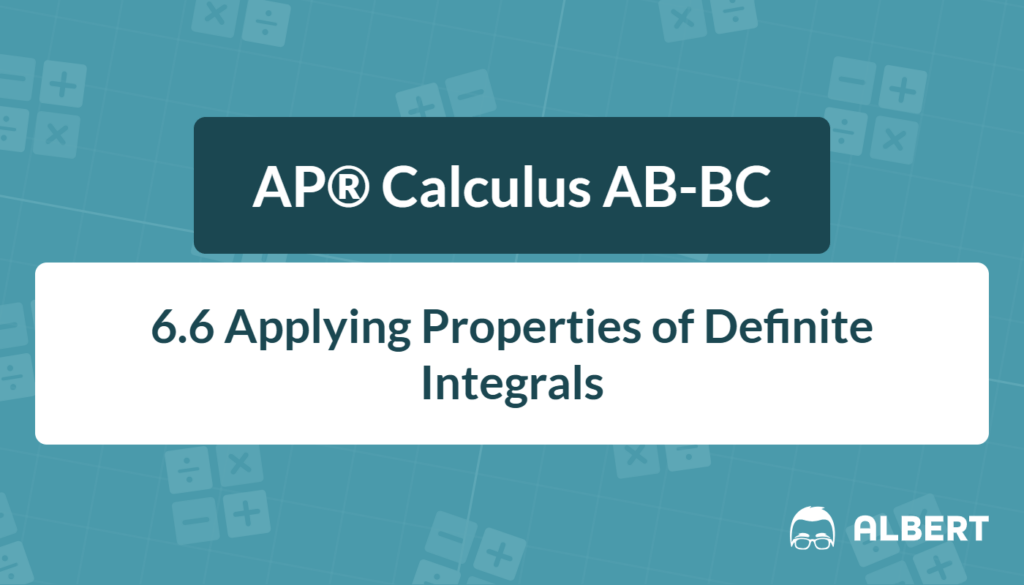Understanding the properties of the definite integral turns long AP® Calculus questions into short, confident solutions. These rules appear in almost every unit, which is why the College Board highlights them in standard FUN-6.A. Below is a student-friendly guide that mixes geometry, algebra, and graphs—exactly the skills tested on the exam.
What We Review
Why Definite Integrals Matter
On free-response and multiple-choice items, integrals measure area, total change, and accumulated quantities such as distance or charge. Therefore, learning the property of definite integrals lets students skip tedious Riemann sums and head straight to an answer.
Area, Geometry, and the Definite Integral
A definite integral equals the net signed area between a curve and the x-axis. If the graph sits above the axis, the area is positive; if below, it is negative. When the region forms a familiar shape, geometric formulas deliver instant results.
Handy Shapes That Save Time
- Rectangle
- Triangle
- Trapezoid
- Semicircle
Step-by-Step Examples
1. Rectangle on a constant graph
- Function: y = 2 on [1,4]
- Base: 4-1 = 3 units
- Height: 2 units
- Area = 3 \times 2 = 6
Therefore,
\int_{1}^{4} 2 dx = 6.2. Semicircle above the x-axis
- Radius: 3
- Interval: [-3,3]
- Full circle area: \pi r^{2} = 9\pi
- Semicircle area: \frac{1}{2}\times 9\pi = \tfrac{9\pi}{2}
Hence,
\int_{-3}^{3} \text{(upper semicircle)} dx = \tfrac{9\pi}{2}.Both results arrive much faster than setting up limits of Riemann sums.
Core Properties of the Definite Integral
Plain-Language List
- Constant multiple
- \int_{a}^{b} kf(x)dx = k\int_{a}^{b} f(x)dx
- (Scaling the height scales the area.)
- Sum or difference of functions
- \int_{a}^{b} [f(x)\pm g(x)]dx = \int_{a}^{b} f(x)dx \pm \int_{a}^{b} g(x)dx
- (You may split or combine.)
- Reversing limits
- \int_{b}^{a} f(x)dx = -\int_{a}^{b} f(x)dx
- (Moving backward flips the sign.)
- Adjacent intervals add up
- \int_{a}^{c} f(x)dx = \int_{a}^{b} f(x)dx + \int_{b}^{c} f(x)dx
- (Areas line up like puzzle pieces.)
Example Set with Solutions
Example 1: Break a polynomial integral.
Find \int_{0}^{4} (3x^{2}-5x)dx.
Step 1: Split using the sum/difference rule.
\int_{0}^{4} 3x^{2}dx - \int_{0}^{4} 5xdxStep 2: Pull out constants.
3\int_{0}^{4} x^{2}dx - 5\int_{0}^{4} xdxStep 3: Use the power rule.
3\left[\frac{x^{3}}{3}\right]_{0}^{4} - 5\left[\frac{x^{2}}{2}\right]_{0}^{4} = 3\left(\tfrac{64}{3}\right) - 5\left(\tfrac{16}{2}\right)=64 -40 =24.Example 2: Flip limits.
If \int_{2}^{5} g(x)dx = 7, then
\int_{5}^{2} g(x)dx = -7 by the reversing rule.Example 3: Use adjacent intervals.
Suppose \int_{-2}^{1} h(x)dx = 7 and \int_{1}^{3} h(x)dx = -2.
Therefore,
\int_{-2}^{3} h(x)dx = 7 + (-2) = 5.These quick moves illustrate the 6.6 properties of definite integrals section in many textbooks.
Extending to Some Discontinuous Functions
Not every function is perfectly smooth. However, integrals remain legal under mild problems.
Types of Discontinuities
- Removable (a hole) – the limit exists but the point is missing.
- Jump – the graph leaps to a new value.
If the function has only a finite number of jumps or holes on [a,b], the area under each continuous piece still adds up.
Graph-Based Example
Consider
f(x)=\begin{cases}1, & 0\le x<2 \ (\text{hole at }2)\\3, & 2< x \le 5\end{cases}Goal: Evaluate \int_{0}^{5} f(x)dx.
Step 1: Split at the discontinuity.
\int_{0}^{2} 1dx + \int_{2}^{5} 3dxStep 2: Find each area.
First piece: (2-0)\times 1 = 2
Second piece: (5-2)\times 3 = 9
Step 3: Add results.
\int_{0}^{5} f(x)dx = 2 + 9 = 11.The missing point at x=2 has zero width, so it does not change the answer. Hence, the properties of integrals still work.
Quick Reference Chart
| Term | Short Definition |
| Definite Integral | Number representing net area from a to b |
| Net Signed Area | Positive above, negative below |
| Constant Multiple Rule | Pull out a factor k |
| Sum Rule | Split or combine integrals |
| Reversing Limits | Flip bounds, change sign |
| Adjacent Intervals | Add neighboring areas |
| Removable Discontinuity | A single missing point |
| Jump Discontinuity | Sudden vertical leap |
Conclusion
Mastering the properties of the definite integral unlocks shortcuts in geometry, algebra, and graph analysis. Constant multiples, sums, reversed limits, and adjacent intervals—plus comfort with small discontinuities—allow students to solve AP® questions in half the time. Therefore, keep practicing geometry shapes, splitting domains, and applying the properties of integrals until each move feels automatic. Exam day will then feel far less stressful and much more successful.
Sharpen Your Skills for AP® Calculus AB-BC
Are you preparing for the AP® Calculus exam? We’ve got you covered! Try our review articles designed to help you confidently tackle real-world math problems. You’ll find everything you need to succeed, from quick tips to detailed strategies. Start exploring now!
- 6.5 Interpreting the Behavior of Accumulation Functions Involving Area
- 6.7 The Fundamental Theorem of Calculus and Definite Integrals
Need help preparing for your AP® Calculus AB-BC exam?
Albert has hundreds of AP® Calculus AB-BC practice questions, free responses, and an AP® Calculus AB-BC practice test to try out.








